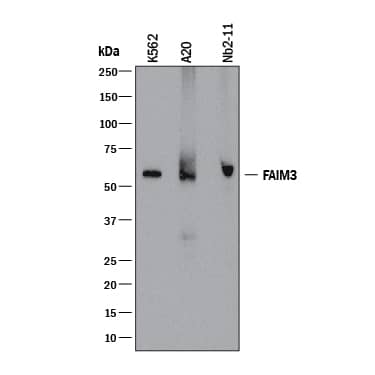Human/Mouse/Rat Fc mu R/FAIM3 Antibody
R&D Systems, part of Bio-Techne | Catalog # MAB9494


Conjugate
Catalog #
Key Product Details
Species Reactivity
Human, Mouse, Rat
Applications
CyTOF-ready, Flow Cytometry, Western Blot
Label
Unconjugated
Antibody Source
Monoclonal Mouse IgG2B Clone # 992338
Product Specifications
Immunogen
Human embryonic kidney cell line HEK293-derived recombinant human Fc mu R/FAIM3
Arg18-Gly251
Accession # O60667
Arg18-Gly251
Accession # O60667
Specificity
Detects human Fc mu R/FAIM3 in direct ELISAs. Detects human, mouse, and rat Fc mu R/FAIM3 in Western blots.
Clonality
Monoclonal
Host
Mouse
Isotype
IgG2B
Scientific Data Images for Human/Mouse/Rat Fc mu R/FAIM3 Antibody
Detection of Human, Mouse, and Rat Fc mu R/FAIM3 by Western Blot.
Western blot shows lysates of K562 human chronic myelogenous leukemia cell line, A20 mouse B cell lymphoma cell line, and Nb2-11 rat lymphoma cell line. PVDF membrane was probed with 2 µg/mL of Mouse Anti-Human/Mouse/Rat Fc mu R/FAIM3 Monoclonal Antibody (Catalog # MAB9494) followed by HRP-conjugated Anti-Mouse IgG Secondary Antibody (Catalog # HAF018). A specific band was detected for Fc mu R/FAIM3 at approximately 60 kDa (as indicated). This experiment was conducted under reducing conditions and using Immunoblot Buffer Group 1.Detection of FAIM3 in HEK293 Human Cell Line Transfected with Human FAIM3 and eGFP by Flow Cytometry.
HEK293 human embryonic kidney cell line transfected with (A) human FAIM3 or (B) irrelevant transfectants and eGFP was stained with Mouse Anti-Human/Mouse/Rat FAIM3 Monoclonal Antibody (Catalog # MAB9494) followed by APC-conjugated Anti-Mouse IgG Secondary Antibody (Catalog # F0101B). Quadrant markers were set based on control antibody staining (Catalog # MAB0041). View our protocol for Staining Membrane-associated Proteins.Applications for Human/Mouse/Rat Fc mu R/FAIM3 Antibody
Application
Recommended Usage
CyTOF-ready
Ready to be labeled using established conjugation methods. No BSA or other carrier proteins that could interfere with conjugation.
Flow Cytometry
0.25 µg/106 cells
Sample: HEK293 Human Cell Line Transfected with Human FAIM3 and eGFP
Sample: HEK293 Human Cell Line Transfected with Human FAIM3 and eGFP
Western Blot
2 µg/mL
Sample: K562 human chronic myelogenous leukemia cell line, A20 mouse B cell lymphoma cell line, and Nb2‑11 rat lymphoma cell line
Sample: K562 human chronic myelogenous leukemia cell line, A20 mouse B cell lymphoma cell line, and Nb2‑11 rat lymphoma cell line
Formulation, Preparation, and Storage
Purification
Protein A or G purified from hybridoma culture supernatant
Reconstitution
Reconstitute at 0.5 mg/mL in sterile PBS. For liquid material, refer to CoA for concentration.
Formulation
Lyophilized from a 0.2 μm filtered solution in PBS with Trehalose. *Small pack size (SP) is supplied either lyophilized or as a 0.2 µm filtered solution in PBS.
Shipping
Lyophilized product is shipped at ambient temperature. Liquid small pack size (-SP) is shipped with polar packs. Upon receipt, store immediately at the temperature recommended below.
Stability & Storage
Use a manual defrost freezer and avoid repeated freeze-thaw cycles.
- 12 months from date of receipt, -20 to -70 °C as supplied.
- 1 month, 2 to 8 °C under sterile conditions after reconstitution.
- 6 months, -20 to -70 °C under sterile conditions after reconstitution.
Background: Fc mu R/FAIM3
References
- Song, Y. et al (2005) J. Biol. Chem. 280(10):9618.
- Shima H et al. (2010) Int. Immunol. 22:149.
- Kubagawa H et al. (2009) J. Exp. Med. 206:2779.
- Proto-Siqueira R et al. (2008) Blood, 112:394.
- Pallasch, C et al. (2008) Blood, 112:4213.
- Pallasch, C P et al (2009) Leukemia & lymphoma, 50:498.
- Sigruener, A et al (2007) Biochemical and biophysical research communications, 359:723.
- Richards R I et al (2016) Front. Neurosci. 10:193.
- Planells-Ferrer L et al (2016) J Neurochem. 139:11.
Long Name
Fc mu Receptor
Alternate Names
FAIM3, FCMR, Toso
Gene Symbol
FCMR
UniProt
Additional Fc mu R/FAIM3 Products
Product Documents for Human/Mouse/Rat Fc mu R/FAIM3 Antibody
Product Specific Notices for Human/Mouse/Rat Fc mu R/FAIM3 Antibody
For research use only
